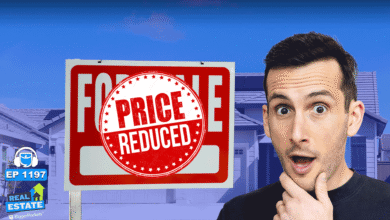
Real estate investors are usually most concerned about rental income and property taxes. They seldom discuss home insurance. Many assume that home insurance is a standard fixed price in most parts of the country and give it scant regard, but you could be making a big mistake if you are one of those people.
According to insurance.com, the average cost of home insurance nationwide hovers around $2,800 per year, which equates to $231 monthly for $300,000 in dwelling coverage and liability and a $1,000 deductible. However, this number fluctuates throughout the country. As a real estate investor, it’s important to note that the numbers quoted are for owner-occupied homeowners insurance. Landlords should add another 25%.
Unsurprisingly, the states with the biggest risk of natural disasters (hail, storms, tornadoes, flooding) have the highest insurance rates. The insurance.com data says the top five most expensive states for home insurance—where average rates range from $4,142 to $5,317 per year—are:
- Oklahoma
- Kansas
- Nebraska
- Arkansas
- Texas
The insurance.com data reveals that the five states with the lowest home insurance rates—where rates range from $582 to $1,551—are:
- Hawaii
- California
- Washington, D.C.
- Vermont
- New Hampshire
Perhaps the most surprising state on the list of low insurance rates is Hawaii. However, don’t be fooled. Hawaii is so cheap because it excludes damage from hurricanes. That’s why, as a landlord, reading the fine print of what your policy does and doesn’t cover is so important.
Although weather is the most important factor in determining your insurance rate, other things to consider include population density, proximity to potential areas of risk such as woodlands (wildfires), rivers, and busy roads, or conversely, proximity to fire hydrants and fire departments. The historical risk for claims in your area could also affect insurance.
How a Landlord Can Lower the Cost Of Insurance
There are things landlords can do to keep the necessary cost of insuring properties as low as possible, including the following.
Ensure your property is well-maintained
Regular maintenance will ensure that cracks, leaks, faulty smoke alarms, mold, and infestations are spotted early and taken care of.
In addition, make sure your property has these features:
- Closed fire doors
- Well-lit hallways
- Clear, clean walkways
- Functional fire escapes
- A strong roof and foundation
Increase your deductible amount
Increasing your deductible (the amount you have to pay before your insurance kicks in) lowers your landlord insurance premium costs and prevents unreasonable claims. By saving money on your premium, you can purchase additional insurance against other claims.
Emphasize safety
An insurance company rewards landlords who take safety seriously. Make sure you emphasize:
- Security cameras
- Interior and exterior lighting
- Alarm systems
- Smoke and CO2 detectors
- Connected smart security devices
Upgrade your property’s main systems
Many insurance claims come from faulty main electrical, plumbing, and heating systems. Ensuring that your system is regularly checked and has been upgraded with modern systems (provide as much information as possible so insurers can verify) helps you get better pricing when it comes time to renew your policy.
Get a master landlord policy
If you have a sizable portfolio, getting all your properties insured under a single policy ensures better premium rates. A master landlord insurance policy also means less paperwork and monitoring of multiple individual policies.
Shop around
You’ll be surprised just how much insurance quotes can differ. Dedicate some time to shopping around. Go online, ask other local landlords which companies or brokers they use, and get multiple quotes.
Insurance Coverage Types for Landlords
As a landlord, these are some things you’ll need to consider including in your policy:
- Rental property insurance: Rental property insurance is standard for landlords and bundles liability, hazard, and loss of income insurance.
- Sewer and water line backup: Some utility/water companies might offer to include this in your monthly bill. However, it’s worth having this written into your insurance policy because if your main water or sewer line breaks, the cost to repair it can run into tens of thousands of dollars.
- Flood insurance: If you’re in a designated flood zone, this is an extra expense you won’t be able to let float by. (In short, don’t buy in a flood zone.)
- Loss of income coverage: If your apartment is rendered uninhabitable due to a natural disaster, loss of rent insurance will cover the lost rent. Some landlord policies include this as standard, but it’s optional for others. Understand, however, that loss of rent insurance does not cover a tenant’s inability to work (through illness or other) and thus not pay rent. Expect to pay around one-third to one-half of the total premium for a landlord insurance policy, so consider this carefully in your overall calculations.
- Tenant rent default insurance: If you can afford this, it might help you sleep better at night. Also known as rent guarantee insurance, this insurance protects landlords from tenants who skip out on paying the rent, keeping your cash flow steady and your blood pressure low.
- Pet insurance: Pet-friendly rental properties are in high demand, and if you want to be competitive, this is something you’ll want to offer, too. If your tenant’s pet attacks another tenant in your building or damages your apartment, you want to ensure you are covered. Ensuring your tenant has pet coverage in their renter’s insurance is one way to go about that. However, local landlord-tenant laws differ from state to state, and you’ll need to check the most cost-effective form of protecting yourself when pets are in your building.
- Umbrella insurance: This is often overlooked by landlords who are concerned with their bottom-line cash flow. However, umbrella insurance can be a godsend if you have the margins. It’s secondary insurance coverage to protect you once the limits on your standard liability policy have been exceeded. It’s especially helpful should you face lawsuits, expenses related to medical attention, and lost wages.
Final Thoughts
Being a landlord is fraught with potential pitfalls. You are at the mercy of the weather and human beings—two unreliable commodities. In your quest for profitability, you must pay attention to possible problems that could leave you penniless. Factoring in worst-case scenarios and ensuring you have the right insurance policy for your investments is crucial.
As you scale, you’ll need to modify your insurance. Time is the great equalizer in real estate, and staying in the game is half the battle. Should you hold on to your assets, over time, your profits will increase, so if you have to spend a little more on insurance at the cost of your cash flow in the short term, it’s wise to consider doing so to ensure you can live to fight another day and increase your profits in the long run.
Ready to succeed in real estate investing? Create a free BiggerPockets account to learn about investment strategies; ask questions and get answers from our community of +2 million members; connect with investor-friendly agents; and so much more.
Note By BiggerPockets: These are opinions written by the author and do not necessarily represent the opinions of BiggerPockets.
Source link







